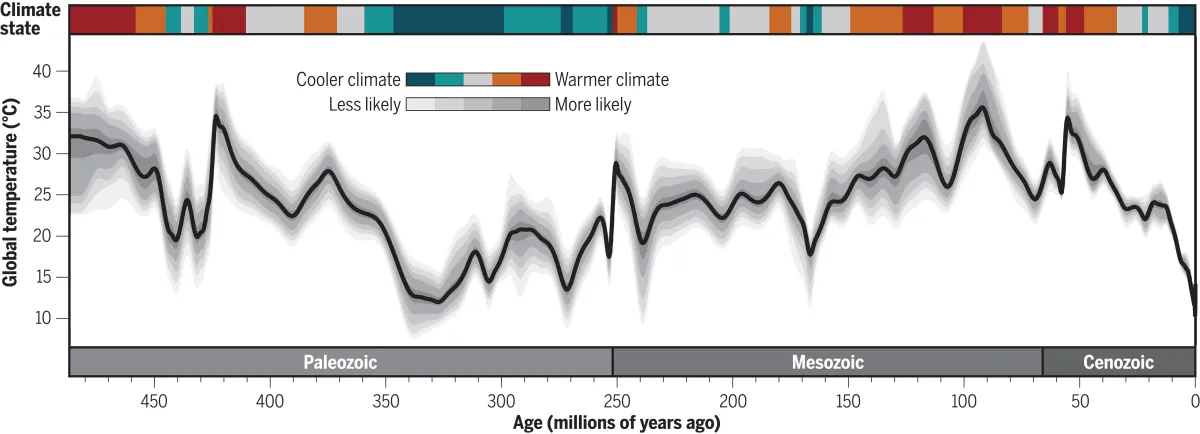
From Ice Ages to Heat Waves: Unraveling 485 Million Years of Earth's Climate Evolution
2024-09-23
The Dramatic Story of Earth's Climate History
Earth's climate history over the past 485 million years tells a dramatic story of transformation and resilience. A new study sheds light on how our planet has navigated fluctuations in ocean levels, ice cover, atmospheric composition, and biodiversity—often punctuated by catastrophic extinction events.
New Study Reveals Climate Variability
The groundbreaking research, entitled “A 485-million-year history of Earth’s surface temperature,” published in the journal Science, reveals significant insights into Earth’s climate variability. Led by Emily Judd from the Smithsonian National Museum of Natural History, this study utilizes the Phanerozoic Data Assimilation (PhanDA) approach, which merges geological data with climate model simulations. This method enables scientists to piece together a more comprehensive picture of Earth's climatic changes over this vast timescale.
Climatic Shifts and Carbon Levels
Since the onset of the Phanerozoic era approximately 538.8 million years ago—a period that marks a crucial era of life's diversification—we’ve witnessed remarkable climatic shifts. Even more startling is the correlation between atmospheric carbon levels and global temperatures over millennia. Presently, CO2 concentrations have surged past 420 parts per million (ppm), driving unprecedented warming that mirrors episodes from the planet's past.
Lessons from the Paleocene-Eocene Thermal Maximum
Co-author Scott Wing, a curator of paleobotany, emphasizes the importance of learning from the Paleocene-Eocene Thermal Maximum (PETM), a period 55 million years ago characterized by rapid global warming—resulting in a temperature increase of 5 to 8 degrees Celsius within just a few thousand years. This swift change led to the extinction of up to 50% of benthic marine life and extensive shifts in plant distribution, including the emergence of subtropical flora at polar latitudes.
The Ongoing Impact of Carbon Emissions
The study underscores a sobering truth: regardless of future emission reductions, the carbon we have already released will continue to impact our climate for centuries. Jessica Tierney, a paleoclimatologist, asserts that the data convincingly demonstrates that carbon dioxide serves as the primary driver of global temperature variations throughout geologic time. The findings highlight an irrefutable trend—when CO2 is elevated, temperatures soar, and when it dips, temperatures plummet.
Unprecedented Temperature Range in Earth's History
Unexpectedly, the researchers found that Earth’s mean global surface temperature (GMST) during the Phanerozoic ranged between a balmy 11°C and a scorching 36°C, disputing earlier assumptions about temperature stability in tropical climates. Currently, the Earth is amidst an ice age, though this era has seen a gradual retreat of ice sheets for thousands of years. Presently, the GMST sits at around 15°C, which is cooler compared to the climate during most of the Phanerozoic era, highlighting our vulnerability to rapid climate shifts.
The Dire Threat of Current Warming
The rapid rate of current warming due to human-generated greenhouse gas emissions poses a dire threat. “Humans and the ecosystems we coexist with are primarily adapted to a cooler climate,” cautions Tierney, emphasizing that the speed at which we are entering a warmer world is dangerous.
Evolving Understanding of Glacial Events
While PhanDA aligns closely with earlier climate reconstructions, new contradictions emerge, particularly regarding the relationship between cold climate periods and glacial events. Earth’s surface is remarkably dynamic, complicating our understanding of climatic history.
Conclusion: Heeding Historical Lessons
In conclusion, the research presents a pivotal piece of the puzzle in understanding our climate's past and future. As the study reveals, our planet's climate is even more sensitive to CO2 levels than previously thought, urging us to reconsider the future of our environment as we grapple with the pressing challenges of climate change. We must heed the lessons of history, for they may hold the key to our survival in the face of looming climatic challenges!
Looking Ahead to Future Discoveries
Don't miss out on how these revelations could change everything we understand about climate change—who knows what breathtaking discoveries lay ahead?



 Brasil (PT)
Brasil (PT)
 Canada (EN)
Canada (EN)
 Chile (ES)
Chile (ES)
 España (ES)
España (ES)
 France (FR)
France (FR)
 Hong Kong (EN)
Hong Kong (EN)
 Italia (IT)
Italia (IT)
 日本 (JA)
日本 (JA)
 Magyarország (HU)
Magyarország (HU)
 Norge (NO)
Norge (NO)
 Polska (PL)
Polska (PL)
 Schweiz (DE)
Schweiz (DE)
 Singapore (EN)
Singapore (EN)
 Sverige (SV)
Sverige (SV)
 Suomi (FI)
Suomi (FI)
 Türkiye (TR)
Türkiye (TR)